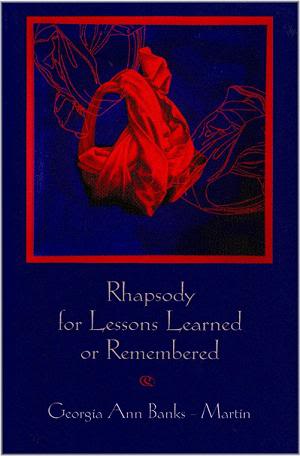Book Review
Georgia Ann Banks-Martin, Rhapsody for Lessons Learned or Remembered, Plain View Press, 2010
by Moira Richards
Ekphrastic poetry is a double-joy type experience for me. I have few skills in the art of really *seeing* visual art work; I once walked twice around a Picasso exhibition and then sat down in desperation to text an art-guru pal for help to see what was invisibly there before me. With just a couple of sms messages she made it possible for me to trawl the gallery once again, but with entirely new eyes. This is what Georgia Ann's book does for me.
Rhapsody for Lessons Learned or Remembered is filled, front cover to back, with dozens of ekphrastic poems. After the poems there is a listing of the titles of the various visual art works that inspired the poetry, for easy referencing. So, with google at my left, and Georgia-Ann's book in my right hand, I began to explore.
Some of the pieces scrutinize life as a black person in predominantly white-skinned USA. For example the poem, "Railroad Station," is written to one of the paintings from Lawrence Jacob's Migration series. The poet's words imagine the thoughts and some of the probable hopes and fears of the faceless, yet so very eloquent, mass of African-American people that Jacobs depicts so well. These are the hundreds upon hundreds of families who left the southern US states and moved with all their belongings in search of a better life in the north during the early years of the 20th century:
Packed: Hopes of work, three bedroom homes,
water heated in water tanks, classrooms.
In the far corner a wife whispers to her husband,
What if here is better than there?
Another poem, "Madonna and Child," speaks to folk artist Clementine Hunter's portrayal of that well-known pair. The narrator reflects on the fact that Jesus (and, in fact, all good people) have always been portrayed, to her, as light-skinned blonde people. And she wonders why Jesus was
never the son of a mother who knelt over
a crib, wearing a bonnet, full black skirt,
white servant's apron,
living in a one-room house.
Some poems look at a still life picture and their poetry conjures memories of the narrator's past, bringing them into sharper focus; bringing the memories to life, as it were. So, with Clementine Hunter's painted vases filled with flamboyant Zinnia flowers:
I remember Mother
placing them between Bible pages
as if she were hiding presents
too precious for Sears Roebucks
And Henri Fantin-Latour's totally different blousy White and Pink Roses lead on to reminiscence of a long-gone grandmother who always wore the same silk rosebud on her lapel because
…There was no money
for freshly wired roses and it didn't concern her:
cut blossoms never live to bloom another year.
Jasmine Becket-Griffiths' sultry black and green fairy, Butterfly Sunset, inspires wistful memories of a tooth-fairy who never visited the narrator's childhood home because "Mother didn't believe in her." Carl Larsson's Self-examination becomes some very humourous introspection from the rather fussy looking and evidently hen-pecked man wearing an artist's smock over a neat suit with, incongruently, a toy clown under his arm. Why? Because
My wife says, Wear your smock
in the studio. Wouldn't want paint
on your shirt when you get to the office!
as she pulls the full white cloth over
my head as if she were dressing our daughter's
daisy circle clown.
This poet also transforms Giacomo Balls' busy-busy painting, Dynamisn of a Dog on a Leash into a delightful and breathless portrayal of the animation and excitement of a doggie out with its owner for their morning walk.
I hardly have my shoes on
before you are jumping,
spinning in tight circles around me.Out the side-door we race down the drive.
A stop at the corner means a Spider Lily
gets extra water,
me, a chance to catch up,
On and on through the collection, Georgia Ann Banks-Martin makes her Rhapsody for Lessons Learned or Remembered a wonderfully exciting and sensory experience for readers. She touches on many different aspects of life in a way that reminds us that art and the everyday are cut from the same fabric. All that's needed are the eyes with which to see the beauty.
Moira Richards lives in South Africa and hangs out here: http://www.darlingtonrichards.com and here: http://www.redroom.com/author/moira-richards. She, with Norman Darlington of Ireland, edits and publishes the annual Journal of Renga & Renku.


